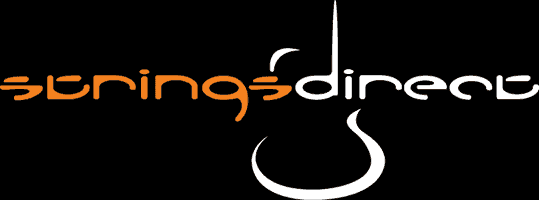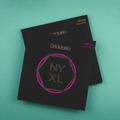10 Beginner-friendly Blues Songs You Should Learn
By Strings Direct – 29 August, 2023

If you want to improve as a blues guitarist, I would recommend learning a range of easy blues songs.
In my opinion, learning new songs is one of the best ways to develop as a guitarist. Learning scales and chords is like learning individual words of a new language. It is useful, but it doesn't actually help you to form sentences, tell an engaging story, or connect with others. To be able to do the latter, you need reference material.
The same is true of learning to play the guitar. If you want to play blues guitar like the greats, then one of the best first steps that you can take is to learn some famous blues songs. This will help you to understand how your favourite players use techniques, scales and chords in practice. You will learn the techniques that they use(d) to create their music. And this will help you to develop your own skills.
Learning songs is not just useful from a developmental perspective either. It will keep your practice and playing fun and interesting. And this is important. After all, if your practice routine is nothing more than a series of rhythmic and technical exercises, the chances of you sticking to it are fairly slim. You are likely to become bored and unmotivated.
So if you are fairly new to the world of blues guitar, then learning a handful of easy blues songs will help to take your playing to the next level. It will immerse you in the world of the blues, and make your practice focused and enjoyable.
And this is what this article is all about. Here I have collected a list of 10 easy blues songs, broken up into categories, which will help you to develop some of the key skills you need to become a great blues guitarist.
Opening thoughts
When you are relatively new to the guitar, one of the biggest challenges is finding material to learn that is suited for your playing level. If you set the bar too low, you won't push yourself to improve and as a result, your progress will slow down. Conversely, if you try to learn very challenging material, there is a risk that you will become overwhelmed and unmotivated.
The songs that I have listed here are aimed at beginner players. But there are a few things to keep in mind here:
Firstly, not all parts of these songs are beginner friendly. Many of the songs have an easy riff for example, but then a blisteringly fast and technically difficult guitar solo.
Secondly, even within this category of 'beginner friendly blues songs' there is some variation. Depending on your playing level, you might fly through some of these songs with little effort, whilst others will require a little more work. And some might be a little too challenging for you to try at this stage.
My advice on both of these points is to take a common sense approach. If 95% of a song consists of a central riff that you feel you can learn quite easily, then I don't think you need to get too worked up about the 30 second guitar solo. It will still be there for you to tackle in a number of months, after you've amassed a few more hours of playing.
Likewise, if you feel that any of the songs in this list is too challenging, then don't let that get you down. Simply find another song on the list, learn that and come back to the more difficult songs later. Learning to assess your playing ability objectively is both challenging and also a skill worth developing. And you can start developing this skill now by trying to objectively decide which of these songs you should try to learn.
Lastly, it is worth noting that this list is not representative of the broad spectrum of amazing blues music out there. Without question there are significant blues musicians and bands that I have omitted here. And certain sub-genres of the blues are also poorly represented in this list.
This is not because these songs are not worth learning. It is just because many of them are challenging, and are best tackled once you have been playing for a bit longer.
Many of the songs on this list are also riff based. This is because, in my opinion, learning riffs works well when you are starting out. Often riffs are not that technically challenging, they are easy to remember and they typically repeat a lot throughout the song. So in this way you can learn to play a full song without having to learn a lot of different material.
Now with those caveats out of the way, let's get into it. Here are 10 easy blues songs that will build your repertoire and help you to improve different areas of your playing:

Mannish Boy - Muddy Waters
Of all of the songs listed here, this is one of the most instantly recognisable. It is one of the most iconic blues guitar riffs of all time, and as such is a lot of fun to play. It is also quite straightforward and repeats throughout the song. So by learning a single riff, you can add a whole new blues song to your repertoire.

Mary Had A Little Lamb - Buddy Guy
A lot of guitarists associate this song with Stevie Ray Vaughan, who performed a fast and furious cover version of the Buddy Guy original. Of the two versions however, Buddy Guy’s is a little easier to learn at first. The riff is fairly straightforward and you don’t need to worry about playing any chords, as the horn section provides those in this song.
There are a couple of more complex guitar solos, which you can work on if you feel comfortable to do so. Otherwise I would recommend working on the central riff. Focus on the precision and clarity of all of your notes, to create the same crisp groove Buddy Guy does in his playing.

Life By The Drop - Stevie Ray Vaughan
Most of Stevie Ray Vaughan’s material is not very beginner friendly. He plays with a lot of speed and intensity, and this makes the majority of his songs technically challenging.
However his short acoustic song ‘Life By The Drop’ is slower and more restrained. There is a little flourish at the beginning, but the song then moves into a fairly simple shuffle at a moderate pace. And this makes it a great choice if you are an SRV fan, but you don’t yet feel ready to tackle some of his more challenging sons.
Vaughan originally played the song on a 12 string acoustic, but it also sounds very effective on a 6 string acoustic or electric too.

Boom Boom - John Lee Hooker
Even if you are not particularly familiar with John Lee Hooker or the name of this song, I suspect that you will have heard the riff. Like ‘Mannish Boy’, the riff in ‘Boom Boom’ is instantly recognisable and very catchy. It also repeats throughout the song, albeit with some small variations.
John Lee Hooker took a very free and loose approach to his guitar playing, and so you can take the liberty to do the same here. Don’t worry so much about precision and instead focus on getting into the groove and enjoying yourself!

Smokestack Lightnin’ - Howlin' Wolf
This song by Howlin’ Wolf shares many similarities with ‘Boom Boom’. Firstly, it is quite recogniseable, even if you might not be familiar with the song. At a more granular level though, the notes that you play here and the construction of the central riff are both very similar to that in the John Lee Hooker song.
So if you like the sound of these classic blues songs, then this could make a great addition to your repertoire. In the original, the guitar has a repeating bass note which plays on the low E string. To play this at the same time as the riff on the treble strings is tricky. So to begin with I would recommend focusing on your treble strings, and work on building the complexity of the guitar part up over time.

Next Girl - The Black Keys
During their career, The Black Keys have created a wide range of heavy blues rock riffs. Of these, the riff that appears in the song ‘Next Girl’ is one of the most beginner friendly.
The guitar part here - as in many of the Black Keys songs - is played with an overdriven guitar sound. So this is a great song to practice if you have an amp with overdrive, or a variety of overdrive pedals. Dialling in a tone with more gain will add more weight to your playing and will really bring this riff to life.

Strange Brew - Cream
If you have started to learn lead blues guitar, you are likely to have encountered the shapes of the minor pentatonic scale. And chances are, you are likely to have encountered these in the key of A.
The lead guitar playing by Eric Clapton in the Cream song ‘Strange Brew’ is constructed solely using the A minor pentatonic scale. As such, it will help you to get familiar with the shapes of the A minor pentatonic scale. You will learn how to move across the minor pentatonic shapes and will start to build a repertoire of licks you can use in your playing.

Born Under A Bad Sign - Albert King
Albert King is widely recognised as one of the most intense and expressive lead blues guitar players of all time. As such, this song represents a great opportunity to hone your lead guitar technique, and work on your bending and vibrato techniques.
Additionally, this song also has a very memorable and iconic riff that plays throughout. So depending on your playing level and interests, you can choose to learn either or both of these elements. Doing so will help you improve your lead guitar techniques in a variety of areas, whilst also learning one of the most iconic blues songs of all time.

Wishing Well - Free
Like many British blues rock songs,’Wishing Well’ has a central and repeating riff, and a fiery guitar solo. However, Paul Kossoff was renowned for crafting solos with only a handful of notes. He let each note really breathe and ring out, and this means that his solos are much more beginner friendly than those of many of his contemporaries.
As such, this song makes a great choice whether you just want to learn the riff, or tackle the whole thing!

Bright Lights - Gary Clark Jr.
Like The Black Keys, Gary Clark Jr. has crafted a wide range of killer blues rock riffs during his career. Of these, I find that the song ‘Bright Lights’ is one of the best for beginners.
It combines simple chord stabs alongside a number of lead section breaks which you can learn to practice your lead guitar playing. The notes themselves are not that challenging, but Clark Jr. brings them to life by focusing on a range of techniques - like palm muting his chords and adding vibrato to his bends. This gives you a great opportunity to work on your technique to inject the same life into your rendition.
Additionally, there is also a long and tricky guitar solo that you can work on in this song, should you feel comfortable to do so.
How to learn these songs
I would recommend learning these songs using a mixture of tablature and learning by ear. Both of these have their strengths and weaknesses, and as such I recommend combining them in your learning approach. Let's look at them both in a bit more detail:
Learning by ear
Developing your ear is an immensely useful skill. It will help you to work out notes, riffs and chord progressions just by listening to them being played. As you progress as a guitarist, this will help you to learn new material much more quickly. It will also help if you have an ambition to play in a band or to jam with other musicians. You will be able to react much more quickly in a live music context. You will also be able to learn without having to consult your laptop or phone to look at tablature.
Having said that, learning by ear can be tricky, especially when you are starting out. As such, I wouldn't try and learn all of the songs listed here by ear. This is likely to be too challenging, and could lead you to feel frustrated and unmotivated. This is particularly the case with the songs that are not riff based. Individual notes are easier to work out by ear than chords.
Learning using tablature

Conversely, it is much easier to learn songs using tablature (tabs for short). I always think of tablature as being a little bit like a musical version of painting by numbers. It is easy to understand and follow, and this makes it great for learning new material. The drawback is that it doesn't help you to develop a broad range of musical skills. Further, like painting by numbers, it doesn't really help you to develop a broad set of creative skills. As such, if you learn solely using tabs, you are robbing yourself of potential development. And this could slow down progress in other areas of your playing further down the line.
Taking a practical approach
To strike the right balance, I would recommend taking the following approach:
If a song is based around chords, or involves more complex lead parts, then use tablature. I would also recommend taking this approach if the guitar in the song is very heavily distorted or uses different effects - as this will make it more difficult to work out by ear.
Conversely, if the song is riff based, then try to work it out by ear at first. If you find it too challenging to work the guitar part out from scratch, then use a tab to find the starting point of the riff. From there, try to work out the next couple of notes. And if you get stuck, have another look at the tab.
By alternating these two approaches, you will be able to learn songs more quickly. This will help to build your repertoire and develop your technique. However, you will also begin to develop a broader set of skills that will make you a better guitarist and musician.
When it comes to actually using tabs, I would personally recommend using a premium service like either 'Ultimate Guitar Pro' or Guitar Pro. Unlike traditional tabs, both of these options provide audio alongside the tab. This allows you to hear the guitar part you are trying to learn, whilst looking at the notes on the tab.
There are a couple of reasons I would recommend going for one of these options:
Firstly, the quality of the tabs that users create to suit these formats is usually better. And this is significant. The last thing that you want to do is spend time learning from a tab, only to discover that it is incorrect.
Secondly, both of these offerings provide you with a variety of tools to make your learning easier and more effective. You can slow down the tempo of the song, isolate the part you are trying to learn, and select tricky sections to repeat on a loop.
Finally and significantly, they also help you to learn from tab and also develop your ear at the same time. You can hear the pitch of the note that is being played and see it on the tab at the same time. And whilst this is not as useful as learning from ear alone, in my opinion it is much better than just looking at tabs without the audio.
Closing thoughts
Whether or not you opt for one of these premium learning tools, your actual approach to learning these songs should remain broadly the same.
Learn these songs one by one. I know how tempting it is to want to learn a whole range of different songs at the same time. But trying to learn in this way is not an effective use of your practice time. I made this mistake for a number of years when I started out. I was constantly jumping from song to song, without really fully learning how to play any one song particularly well.
Additionally, take your time to learn these blues songs. It is much better to be able to play one or two songs very well, than to be able to play a wide range of songs poorly. Take a granular approach to your learning. Look at the techniques used in the songs, and the little nuances that make the riffs, chord progressions and solos so effective. It might take you a little longer to learn the songs in the beginning. But it will make you a significantly better guitarist and musician in the long run.
Lastly, have fun! You should enjoy the process of learning these songs, so don’t get so wrapped up in making progress that you forget to enjoy yourself!

The Happy Bluesman
www.happybluesman.com
@happybluesman






